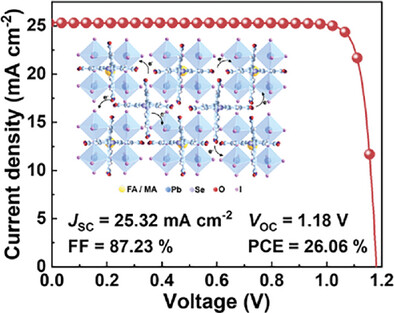Dimensional Regulation of Organic n-Type Dopants for Highly Efficient Perovskite Solar Cells and Modules
Liu, C., Zuo, C., Xue, Q., Lin, D., Liu, T., Luo, J., Huang, H., Chen, K., Gao, Y., Zeng, J., Zhang, Y., Xu, B., Yang, T., Mai, Y., Zou, B., Brabec, C.J., Hu, X.
Advanced Materials, 2025, 2417251.
A strong n-type perovskite layer is crucial in achieving high open-circuit voltage (VOC) and power conversion efficiency (PCE) in the p-i-n solar cells, as the weak n-type perovskites result in a loss of VOC, and the p-type perovskites contain numerous electron traps that cause the severe carrier recombination. Here, three types of perylene diimide (PDI) based small molecule dopants with different dimensions, including 1D-PDI, 2D-PDI, and 3D-PDI are designed, to produce heavier n-type perovskites. The PDI-based molecules with Selenium atoms have a strong electron-donating ability, effectively enlarging the quasi-Fermi level splitting within the perovskites. Besides, the PDI molecules can coat the surface of the perovskite crystal to form the lattice cage through their conjugate skeletons, which passivates the trap states and improves the n-doping efficiency, as well as the stabilities of perovskites and related devices. With the addition of the 2D-PDI, the small-area solar cells achieved a PCE of 26.06% (25.44% certified) with a high VOC of 1.18 V and a remarkable fill factor of 87.23%. Furthermore, the rigid and flexible perovskite solar modules yielded high PCEs of 21.48% and 20.71%, respectively. This dimensional regulation strategy provides useful guidance for effective n-type doping and high-performance p-i-n solar cells

